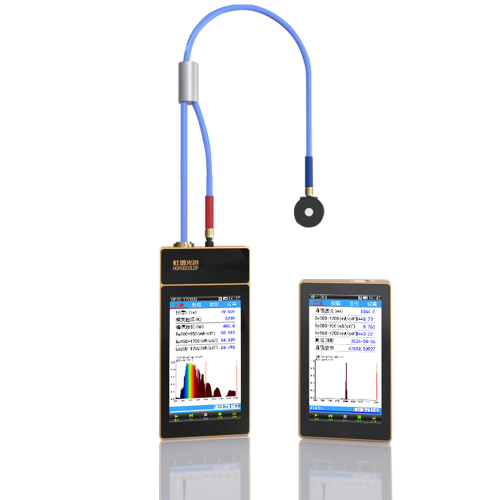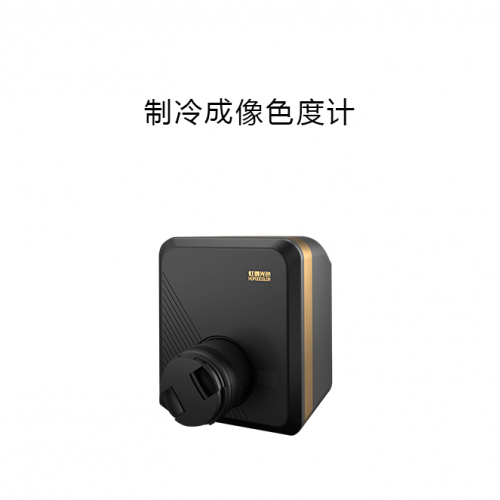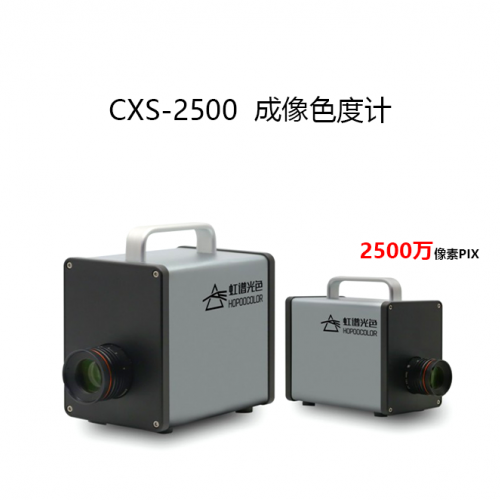Flicker frequency spectrum analyzer(OHSP-350F):use data to teach you how to choose lamps to avoid flicker frequency hazards in 2019
20 Mar, 2019
When people are in a lighting environment, it does not seem to be noticeable. In fact, in addition to warning-like flashing marks or lamp failures, there is not much intuitive perception of the concept of strobe. When observing the rotating fan blades, it is found that the blades are sometimes "stationary" and sometimes "rotating", and this phenomenon can also occur in the running car tires, which can be explained as the visual persistence caused by the stroboscopic light source.
In the figure below, there is a white point on the black disc. When the disc rotates, the continuous change of graph a will occur under the condition of no flicker frequency illumination. Under the fluctuating frequency flash source, the phenomenon of graph b will appear.
a general b flicker frequency
Flicker frequency cause
The flicker frequency light source is essentially that the light emitted by the light source exhibits a certain frequency and periodic change with time, and changes with time between different brightness and color. If the driver of the lamp does not have suitable electronic circuits, such as ballasts, drives or power supplies, the source will flicker frequency, the greater the fluctuation of the output luminous flux, the more severe the flicker frequency.
The technical mechanism of flicker frequency generation has not only the factors of power supply, but also the performance factors of electric light source technology and the unreasonable factors of lighting design. For many lighting fixtures, the operating current of the light source must fluctuate with fluctuations in the input voltage, directly causing flicker frequency fluctuations in the light output.
Taking the incandescent lamp as an example, the driving is 50 Hz AC mains, and the light flickering frequency is 100 Hz after the negative half cycle and the positive half cycle are superimposed; the gas discharge lamp using the inductive ballast also fluctuates with the fluctuation of the power supply frequency. In addition, the instantaneous fluctuation range of the power supply grid is between 10% and 20%, which deepens the light fluctuation of the lighting fixture.
Commonly used flicker frequency index to describe the flicker frequency degree of the light source, the integrated flicker frequency ratio and two other variables: optical waveform and duty cycle. Wherein, the flicker frequency ratio is equal to the difference between the maximum light output and the minimum light output in one switching cycle divided by the sum of the maximum light output and the minimum light output, and the flicker frequency index is equal to the amount exceeding the average light output in one switching cycle divided by the total light output. . The lower the flicker frequency ratio and the flicker frequency index, the less the flicker frequency effect caused by the flashing of the light source.
the flicker frequency measure of general light source
Flicker frequency hazard
First, photosensitive epilepsy or scintillation-induced epilepsy:
Fisher estimates the incidence of photosensitive epilepsy in people aged 5 to 24 by measuring abnormal brain waves of light stimulation. The incidence rate is between 0.01% and 0.025% in people aged 5 to 24 years, and 2% to 14% in patients with epilepsy under the stimulation of flashing light sources. The chance of inducing rapid epileptic seizures. The American Epilepsy Work Foundation pointed out that the factors influencing the symptoms of photosensitive epilepsy include scintillation frequency, light intensity, modulation depth, spectral composition and some factors related to the visual nervous system.
Second, the visual persistence effect caused by flicker frequency
Bullough et al. used a series of waveforms and frequencies to study the flicker frequency effect of a solid-state light source and found that the drive modulation depth, frequency, duty cycle, and waveform have an impact on the visibility of the flicker frequency effect.
Bullough experiment of flicker frequency research
general light source and flicker frequency light source
Third, headache, nausea, visual disorders and other physiological problems
The American Headache Society points out that many people with migraine headaches are more sensitive to light, especially glare, bright light sources with flicker can cause migraine, and low-frequency flicker is more severe than high-frequency flicker; some flashing fluorescent lights or TV screens can cause migraine-like Symptoms, many studies have also shown that for these scintillation-induced migraine patients, their EEG is usually different from those without migraine. However, the physical discomfort caused by those factors of the scintillation source has not yet reached a definitive conclusion.
Fourth, use eye fatigue, vision loss
The flashing of the lighting fixtures often affects human productivity. When studying the effect of flicker on people's fatigue level, it is found that the mental fatigue caused by flicker is very small, and the main factor causing human fatigue is the work content; non-visible flicker can affect the movement trajectory of the eyeball, affecting reading and causing vision loss. Studies by Wilkins et al. have shown that visual correlation performance at higher frequency scintillation sources is better than low frequency sources.
Flicker frequency criterion
IEEE issued the IEEEPAR1789:2013 "Draft Risk Assessment-Potential health effects of flicker from LED lighting" in April 2013. The grading criteria are shown in the following figure. The unaffected areas in the figure are shown in green, and the low-risk areas are in orange. Indicates:
The relationship between the flash frequency and the fluctuation depth function of low risk and imperceptible levels of influence
The document pair flicker frequency standard are:
(1) The frequency is lower than 9 Hz, and the undetectable fluctuation depth limit is 0.288%;
(2) The frequency is in the range of 9-3120 Hz, and the undetectable fluctuation depth limit is: frequency × 0.032%;
(3) The frequency is greater than 3120 Hz, and it is considered that there is no flicker frequency at all, and the assessment is exempted.
How to reduce flicker frequency
Analysis of the cause of flicker frequency, it can be found that the key to reduce flicker frequency is electric light source technology and drive technology. If the LED is driven by a constant, non-oscillating DC source, the flicker frequency effect can be achieved. Drivers in the market also need to consider driving costs, size, reliability, efficiency and other factors, manufacturers and industry experts also try to find a flicker frequency level that people can accept.
MENU
- Home
- Products
- Goniophotometer system
- Spectroradiometer sphere system
- Glare and daylighting coefficient detection system
- Luminance Tester
- UV Irradiance Tester
- IR Irradiance Tester
- Red and Blue light Irradiance Test
- Transmittance and reflectance Tester
- Flicker and Lux Tester
- HPL-200 Wireless Luxmeter
- HPCS300 Mini Spectrometer
- OHSP-350C Spectral Irradiance Colorimeter
- OHSP-350 Portable Spectral irradiance colorimeter (With Software)
- OHSP-350F Spectral Flickering Colorimeter
- OHSP-350F Spectral Flickering Colorimeter
- OHSP350Z Spectrometer Light Intensity Tester
- OHSP350SF Multi Function Spectrometer
- Rs485 Mode Industry Tester
- Grow light Tester
- About Us
- News
- Video
- Service
- Contact Us
BEST SALE
HANGZHOU HOPOO LIGHT&COLOR TECHNOLOGY CO.,LTD.
Hangzhou Hoptek Technology Co.,Ltd located in Great Economic Circle in Hangzhou.High-tech enterprises engaged in research and development, production, sales and service of optical testing equipment. The company …
Read More sales_fob@hopoocolor.com
sales_fob@hopoocolor.com




